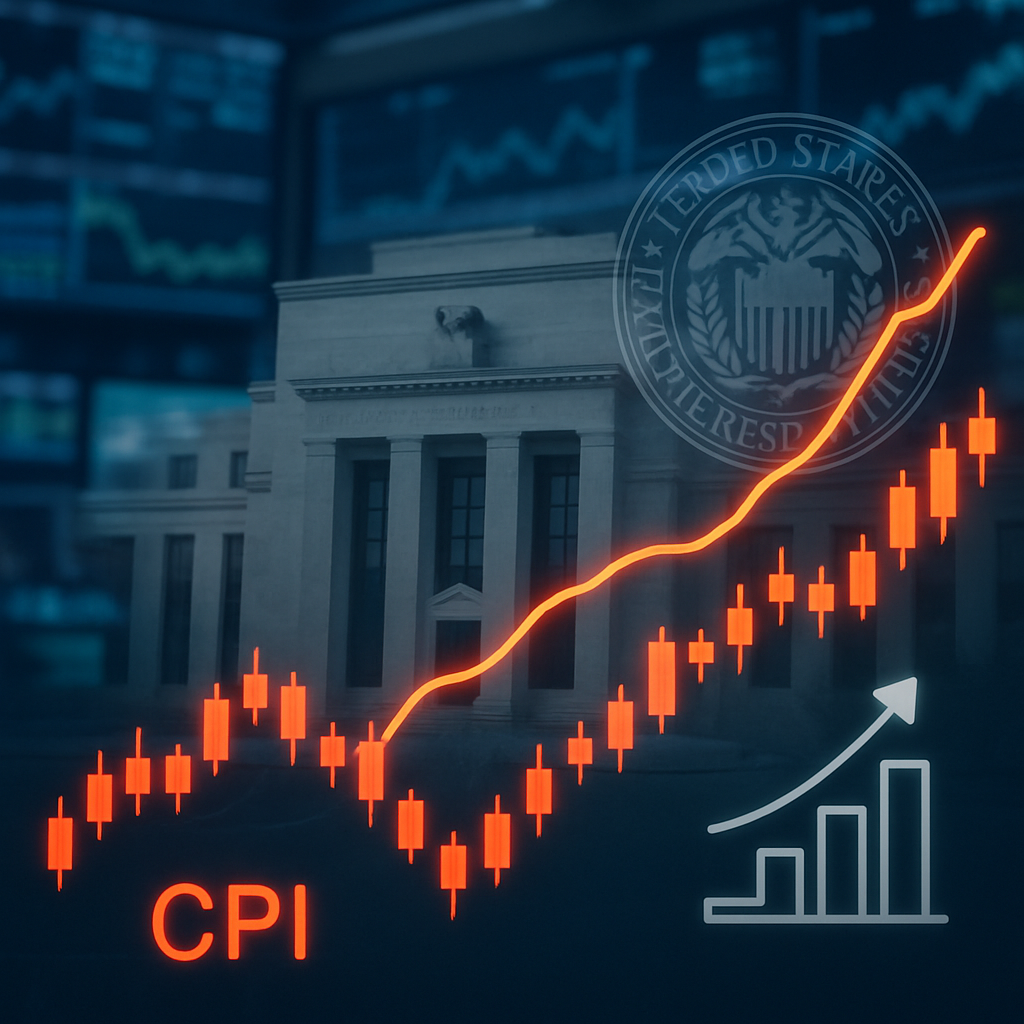
The specter of persistent inflation, stubbornly holding above the Federal Reserve's long-term target of 2%, is casting a long shadow over the U.S. economy and financial markets. Recent data reveals a concerning trend where core inflation metrics, stripping out volatile food and energy prices, are accelerating, prompting the central bank to re-evaluate its path forward. This sustained inflationary pressure threatens to keep borrowing costs higher for longer, potentially stifling economic growth, eroding consumer purchasing power, and introducing significant uncertainty into investment strategies.
The Federal Reserve, caught between its dual mandate of achieving maximum employment and maintaining price stability, faces a precarious balancing act. While recent statements from Chair Jerome Powell hint at a potential pivot towards interest rate cuts, the underlying inflationary current suggests that such relief might be more delayed or modest than markets initially anticipated. This complex environment demands careful navigation by businesses and and investors alike, as the repercussions of higher-for-longer rates ripple through every sector of the economy.
The Persistent Price Problem: Why Inflation Stays Above Target
The current inflationary environment is more complex than a simple post-pandemic rebound; it represents a confluence of factors that continue to push prices upward, challenging the Federal Reserve's efforts to return to its 2% target. In July 2025, the annual U.S. Consumer Price Index (CPI) remained at 2.7%, consistent with June, while the core CPI, a more telling indicator of underlying price trends, accelerated to a five-month high of 3.1%. The Fed's preferred gauge, the Personal Consumption Expenditures (PCE) Price Index, also saw its annual change rise to 2.6% in June, with core PCE estimated at 2.7%. These figures, consistently above the 2% goal, underscore a persistent problem.
Several key areas are contributing significantly to this inflationary pressure. Shelter costs, driven by chronic supply shortages, continue to be a substantial factor, increasing by 3.7% year-over-year in July. Transportation services (3.5%), used cars and trucks (4.8%), and new vehicles (0.4%) also saw notable price hikes in July. Medical care costs rose by 3.1%, with specific surges in home healthcare (10%) and nursing home care (nearly 5%). Automobile insurance saw a significant jump of 12.7%. Moreover, the imposition of new tariffs is identified as a potential future inflationary driver, with their full effects expected to accumulate over the coming months.
The timeline leading up to this moment has been characterized by a gradual disinflation from the peaks of 2022, but with recent plateaus and even upticks in core measures. Initially, supply chain disruptions, robust consumer demand fueled by fiscal stimulus, and energy price volatility were primary drivers. While some of these pressures have eased, a tight labor market, persistent wage growth, and now, potentially, trade policy adjustments are maintaining upward pressure on prices. The key players involved are primarily the Federal Reserve, which sets monetary policy, and various government agencies whose fiscal and trade policies can also influence inflation. Initial market reactions to this persistent inflation include heightened volatility and a recalibration of interest rate expectations, with investors grappling with the prospect of fewer or delayed rate cuts.
Navigating the Tides: Who Wins and Loses in a High-Rate Environment
The sustained period of elevated inflation and higher interest rates creates a clear demarcation between potential winners and losers in the corporate landscape. Companies with robust balance sheets, strong pricing power, and those in sectors that inherently benefit from rising rates are better positioned to weather the storm, or even thrive. Conversely, highly leveraged businesses, interest-sensitive sectors, and those reliant on discretionary consumer spending face significant headwinds.
In the financial sector, banks, insurance companies, and brokerages often emerge as beneficiaries. Banks like Bank of America (NYSE: BAC) can see their net interest margins expand, boosting profitability as they earn more on loans than they pay on deposits. Insurance providers such as Allstate (NYSE: ALL), AmTrust Financial (NASDAQ: AFSI), and Travelers (NYSE: TRV) benefit from higher returns on their investment portfolios, which are often heavily weighted towards interest-sensitive assets. Similarly, financial services giants like Principal Financial Group (NASDAQ: PFG) and brokerages like Charles Schwab (NYSE: SCHW) and Goldman Sachs (NYSE: GS) can experience increased interest income and activity.
The energy and commodity sectors also tend to perform well, as their prices are often a core driver of inflation. Companies involved in oil and gas exploration and production, such as Phillips 66 (NYSE: PSX), see the value of their assets and products appreciate, leading to higher revenues. Businesses with strong pricing power, particularly in consumer staples and healthcare, can pass on increased input costs to consumers without significant demand erosion. Walmart (NYSE: WMT), for instance, can attract value-conscious consumers, while healthcare providers like McKesson (NYSE: MCK) offer essential, less price-sensitive services. Tech giants with substantial cash reserves, like Apple (NASDAQ: AAPL), Microsoft (NASDAQ: MSFT), and Alphabet (NASDAQ: GOOGL), can even generate significant interest income from their cash holdings, offering a buffer against rising borrowing costs. Berkshire Hathaway (NYSE: BRK.A, BRK.B), with its diverse portfolio of essential businesses and strong cash position, also exemplifies resilience in such an environment.
On the losing side, companies with high debt levels are particularly vulnerable. Higher interest rates directly increase their borrowing costs, squeezing cash flow and profit margins. This impacts not only large, leveraged corporations but also smaller businesses and startups that rely heavily on loans for operations and expansion. Interest-sensitive sectors such as manufacturing, construction, and real estate development face significant challenges. Higher mortgage rates deter potential homebuyers, slowing down residential construction, while increased financing costs for projects can delay or cancel new capital investments for manufacturers.
The consumer discretionary sector also bears the brunt of persistent inflation and high rates. As consumers grapple with higher credit costs (mortgages, auto loans, credit cards) and eroded purchasing power, their willingness to spend on non-essential goods and services diminishes. This leads to reduced sales for retailers of luxury items, hospitality businesses, and entertainment companies. Furthermore, growth stocks, often valued on the promise of future earnings, see their present valuations diminish as higher discount rates are applied to those distant cash flows, making them less attractive in a high-rate environment.
Economic Headwinds: Industry Impact and Broader Implications
The persistent inflationary environment, coupled with the Federal Reserve's commitment to higher interest rates, sends pervasive ripple effects throughout the economy, reshaping industries, influencing global trade, and demanding careful regulatory oversight. The fundamental erosion of purchasing power impacts consumers and businesses alike, while rising input costs compress profit margins, potentially ushering in a period of "mild recession" or even "stagflation"—a challenging combination of high inflation and increasing unemployment.
Across industries, companies face significant margin compression due to elevated fuel prices, labor shortages, and rising raw material costs. This often necessitates intense renegotiation of contracts with suppliers and partners, introducing instability and friction within supply chains. The struggle for profitability intensifies competition for market share, favoring businesses with strong pricing power, diversified supply chains, or insulation from import competition. Conversely, established market leaders might find their negotiation power waning, creating avenues for smaller, more agile competitors to gain ground. This environment also compels companies to re-evaluate and restructure global supply chains, leading to increased efforts in reshoring or nearshoring to mitigate risks and control costs, creating opportunities for domestic logistics and manufacturing but challenging international trade.
Regulatory and policy implications are profound. Central banks, particularly the Federal Reserve, are under immense pressure to maintain a hawkish monetary policy, meaning interest rates could remain elevated for longer or even see further hikes if inflation fails to recede sustainably. This stance significantly impacts government fiscal health by increasing borrowing costs on the national debt. Moreover, rapid interest rate hikes can expose "fault lines" within the financial system, as evidenced by recent bank failures in 2023. These events underscore the delicate balance policymakers must strike between aggressively fighting inflation and ensuring financial stability. Macroprudential authorities are also scrutinizing accumulated risks in the financial system, such as household debt servicing capacity, to pre-empt broader crises.
Historically, this situation echoes the "Great Inflation" of the 1970s, a period marked by "stagflation," high unemployment, and inflation that peaked at over 14% by 1980. That era, fueled by excessive money supply growth and oil crises, demonstrated the severe trade-offs involved in taming inflation. Paul Volcker's aggressive interest rate hikes, which pushed the federal funds rate to 19% in 1981, successfully broke the inflation cycle but also triggered a deep recession. This historical precedent serves as a stark reminder of the potential economic pain associated with bringing stubborn inflation under control, and the critical role of central bank independence amidst political pressures. Furthermore, history shows that six of the nine periods of rising interest rates in the U.S. since 1970 have been followed by recessions, highlighting the inherent risks.
The Road Ahead: Navigating Persistent Inflation
The path forward for the global economy and financial markets amidst stubborn inflation and high interest rates remains fraught with uncertainty, demanding strategic foresight from policymakers, businesses, and investors. In the short term, the prevailing expectation is for interest rates to remain elevated, potentially for longer than many anticipated. While the Federal Reserve Chair Jerome Powell hinted at possible rate cuts as early as September 2025 due to a softening labor market, this pivot is contingent on inflation data showing a clear and sustained downward trend. If core inflation proves stickier, the Fed's hands might be tied, leading to further economic uncertainty and potential market repricing of risk assets.
Looking at the long term, the risk of persistent inflation could lead to sustained higher real interest rates, acting as a continued drag on global economic activity. Some economists question the feasibility of a smooth return to the 2% inflation target, citing factors like resilient consumer cash reserves, the "lock-in effect" from fixed-rate mortgages, and ongoing federal deficit spending. Businesses must implement strategic pivots to navigate this landscape. This includes a rigorous focus on cost control and efficiency, dynamic pricing strategies that prioritize high-margin products, and strengthening supply chain resilience through diversification and domestic alternatives. Prudent cash flow and debt management, coupled with diversification and innovation in products or services, will be crucial for maintaining profitability and market share. Comprehensive scenario planning and stress testing are essential tools for anticipating and responding to potential disruptions.
For investors, market opportunities lie in inflation-indexed securities like Treasury Inflation-Protected Securities (TIPS), real assets such as commodities and real estate (including REITs), and equities of companies with strong pricing power, particularly in consumer staples and energy sectors. Value stocks may also be favored over growth stocks. If interest rates do begin to fall, rate-sensitive sectors like real estate, utilities, infrastructure, technology, and consumer discretionary could see renewed interest. However, significant market challenges persist, including higher borrowing costs across the board, reduced asset valuations as future cash flows are discounted at higher rates, and continued pressure on rate-sensitive sectors like housing and commercial real estate. The OECD also warns of potential financial fragilities within the banking system if interest rates continue to rise rapidly.
Potential scenarios and outcomes range from a prolonged "higher for longer" rate environment, leading to a continued economic slowdown, to a more severe outcome where "something breaks" in the financial system due to persistent restrictive policy. A "soft landing" remains the Federal Open Market Committee's (FOMC) aspiration, but with an extended timeline and heightened risks. There's also a possibility that if inflation proves exceptionally persistent, central banks might eventually be forced to adjust their 2% inflation targets. Ultimately, the effectiveness of monetary policy may continue to be dulled by existing financial conditions, making the fight against inflation a prolonged battle.
Conclusion: A Vigilant Approach in an Unsettled Market
The current financial landscape is defined by the enduring challenge of inflation, which continues to defy the Federal Reserve's target and reshape economic expectations. The key takeaway from this period is the necessity for adaptability and strategic resilience across all sectors. The prospect of "higher for longer" interest rates implies a continued premium on financial prudence, efficient operations, and robust balance sheets for businesses.
Moving forward, the market will remain sensitive to incoming inflation data, labor market indicators, and the Federal Reserve's communications. Investors should anticipate continued volatility as the central bank navigates its dual mandate, striving for price stability without triggering a severe economic downturn. The potential for fewer or delayed interest rate cuts means that the cost of capital will remain a significant factor, favoring companies that can generate strong cash flows internally or have minimal reliance on external financing.
The lasting impact of this inflationary cycle could manifest in several ways: a sustained focus on supply chain localization and diversification, a re-evaluation of growth stock valuations, and a renewed appreciation for tangible assets and companies with genuine pricing power. What investors should watch for in the coming months includes the trajectory of core inflation metrics, any shifts in the Federal Reserve's forward guidance, and the health of the commercial real estate sector, which could pose systemic risks. The ability of both the economy and financial markets to absorb these ongoing pressures will ultimately determine the shape of the recovery and the return to a more predictable economic environment.





